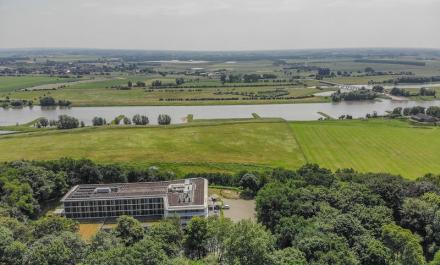When the melt water is missing: More often low water expected in the Rhine in the future.
As a result of global warming, Alpine glaciers are melting and the snow cover in winter is becoming thinner. As a result, the runoff contribution from snow and glacier melt in the river Rhine will decrease in the future, as shown by the scenarios calculated in the CHR research project (on the influence of climate change on Rhine runoff) for the near (2031-2060) and far future (2071-2100). This meltwater contribution is crucial as a water reserve for months with less precipitation in summer and autumn.
CHR symposium: Streamflow components will change!
Representatives of universities, authorities and other organisations followed the presentation of the results with great interest. All scientists involved and the CHR representatives hope that this study will contribute to a (more) careful use of water resources in the future. A further coordination and coupled distribution of tasks of the CHR with the other commissions in the Rhine river basin is foreseen in autumn.
Impact of climate change on the rain, snow and glacier melt components of streamflow of the river Rhine and its tributaries
Code
The streamflow of the river Rhine and its tributaries consists of rain, snowmelt, and glacier ice melt. These components have already changed in the past decades due to global warming. This project quantified the daily fractions of the rain, snowmelt, and glacier ice melt components for a future climate scenario for all tributaries and along the main river Rhine. An ensemble of projections until 2100 suggests wetter winters and drier summers in the future. Hydrological model simulations with this forcing show that the rain component will dominate the seasonal variability of streamflow in the future more than it has in the past. Snow will melt earlier in winter and spring, resulting in less seasonal water storage in the snowpack. Glacier retreat will continue, and despite different rates of retreat of individual glaciers, the joint ice melt component in the main river Rhine is projected to decrease rapidly and almost disappear by the end of the century. Special stress-test model experiments show that the declining melt components will especially affect low flows downstream. At the end of the century, this means that in hot and dry summers comparable to those in 2003 or 2018 buffering ice melt or low flow augmentation will no longer be available. Overall, according to the simulations, streamflow variability and low flow extremes will increase. Despite the uncertainties reflected in the range of downscaled and bias-corrected climate model data, the projected changes are a clear mandate to reconsider water uses and conservation goals along the river.
Report of the 88th meeting of the CHR
Code

The CHR members met live in Wageningen in the Netherlands. This meeting was followed by the CHR jubilee symposium. The pandemic situation was by that time acceptable only for vaccinated people.
CHR sediment project completed; results available
During the last one and a half years, BOKU University (Vienna, Austria) and Blueland Consultancy (Netherlands) - on behalf of the CHR - have been working on an inventory for sediment regarding knowledge, activities, research and monitoring at catchment level. This has resulted in a state-of-the-art report which is now available, check the project HERE
CHR Symposium "The River Rhine in a future climate: Changes from headwaters to lowlands"
Climate change will strongly affect the hydrology and the water management along the River Rhine. With its headwaters in the Alps and several major tributaries from other central European mountain ranges, the hydrological regime is particularly influenced by changes in glaciers and snow. The international Commission for the Hydrology of the Rhine Basin (CHR) has therefore initiated a project with the aim to analyse and simulate the changes in the streamflow components of the Rhine from glacierized and non-glacierized parts of the basins together.
Annual report of the CHR 2020 published!
The annual report contains information about meteorological and hydrological status of the Rhine basin of the year 2020. In addition, the activities carried out by CHR in 2020 have been described.